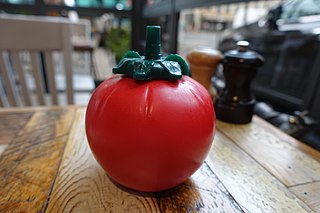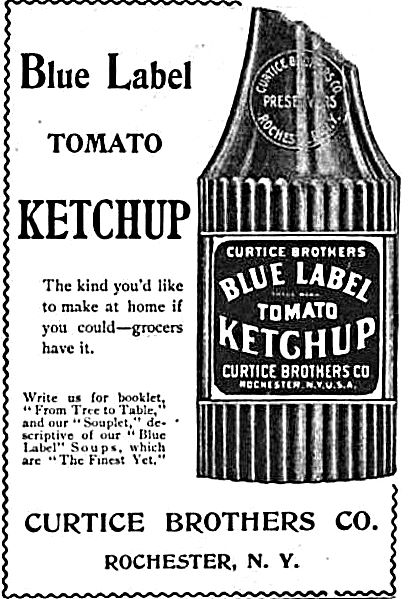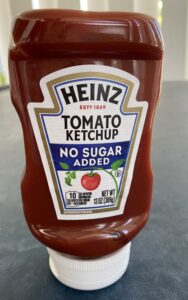
Ketchup is the go-to of all American condiments. In fact, the average American consumes 71 pounds of ketchup each year.
[Incidentally, this 1953 advertisement by Alcoa Aluminum uses the Del Monte catsup bottle as a prop to demonstrate how easy it is to open aluminum screw tops.]
It’s easy to understand why Alcoa used a ketchup bottle for its demonstration. Almost every American has ketchup in their cupboard, because it’s the condiment that goes with everything from hot dogs, hamburgers, and fries to meatloaf, pot roast, and scrambled eggs. I even know one woman, who shall remain nameless, who adds ketchup to runny soft-boiled eggs.

In other words, ketchup goes with just about anything edible whether its purpose is to enhance flavor or cover it up. And, in a word association test, most Americans associate ketchup with tomatoes, despite the fact that ketchup can be made out of almost anything.
Is the correct word CATSUP or KETCHUP?
Ketchup began in China as a pickled sauce made from fermented fish. The sauce was variously known as ke-tsiap in Hokkien Chinese, k`ēchap in Cantonese Chinese, or kēhap in Malay Chinese. When the term migrated into English, some people spelled the word as catsup; others as ketchup. In the late 1900s, ketchup began pulling ahead as the preferred spelling, and won the competition in 1988 when Del Monte changed the spelling of its product from catsup to ketchup.
Early Ketchups
The British liked ketchup, and took the tasty sauce home with them in the 18th century. They made ketchup out of mushrooms, walnuts, oysters, anchovies, lemons, celery, plums or peaches. One recipe for oyster ketchup featured 100 oysters, 3 pints of white wine, and lemon peels spiked with mace and cloves for a spicier flavor.

Charlotte Mason’s 1787 Lady’s Assistant for Regulating and Supplying Her Table included this recipe for a Ketchup of Walnuts. Bruise a hundred or two of walnuts, just before they are fit to pickle. squeeze out the juice. Let it stand all night. Boil it. When the anchovies are dissolved, strain the liquor. add half a pint of red wine, a gill of vinegar, ten cloves of garlic, mace, cloves and nutmeg, half a quarter of an ounce each, pounded. Let this simmer till the garlic is tender.
No 18th century ketchup used the poison apples we now call tomatoes.
This video shows how 18th century Americans made mushroom ketchup. To find out how tomatoes took over ketchup, skip to the section after the video.
Tomato Ketchup Becomes Popular
One of the first recipes for a tomato ketchup comes from James Mease of Philadelphia in 1812. He favored tomato pulp, unknown spices, and brandy. Jonas Yerkes came out with the first bottled ketchup in 1837.

Early ketchup producers faced a challenge, because the tomato growing season was short and they needed to preserve the tomato pulp. Favored preservatives were coal tar derivatives and sodium benzoate. However, these weren’t healthy choices.
Enter Dr. Harvey Washington Wiley who suggested preservatives weren’t needed if the ingredients were of high quality and properly used. Wiley took his theories to Henry J. Heintz of Pittsburg who launched Ketchum in 1876. The recipe used tomatoes, (which were processed the same day they were harvested), distilled vinegar, brown sugar, salt and spices. One version featured allspice, cloves, cayenne pepper, mace, and cinnamon. Another set of spices included pepper, ginger, mustard seed, celery, salt and horseradish.

During the 1880s, Heinz changed the name of his product to Heinz Tomato Ketchup, and added “57 Varieties” to the label. At the time, Heinz produced 60 flavors of ketchup, but he liked the number “57” better than “60.” Or, perhaps he thought it looked better on the label. In 1905, Heintz sold 5 million bottles of ketchup.
Heinz wasn’t, and still isn’t, the only ketchup producer. According to Statista, 197 million Americans used Heintz ketchup in 2019. But 86.29 million used Hunt’s ketchup; 37.2 million used a store brand; and 28.24 million consumed Del Monte ketchup. Ketchup production is about 12 million tons a year with a value of over $900 million.
🍅🍅🍅
Images:
“You Mean a Woman Can Open It?” Advertisement for Alcoa Aluminum. 1953.
Tomato Shaped Ketchup Container by Builhem Vellut.
Geo. Watkins Mushroom Ketchup.
Blue Label Tomato Ketchup. 1898.
Heinz Ketchup. Photo by Author.
“Catsup vs. Ketchup: What’s the Difference?” Writing Explained.
“U.S. population: Which Brands of Catsup/Ketchup do You Use Most Often?” Statista. Aug. 20, 2019.
Kevin Carter. “Did George Washington Use Ketchup?” Savoring the Past. Aug. 1, 2012.
Peggy Trowbridge Filippone. “The History of Ketchup.” The Spruce Eats. Feb. 12, 2019.
Jasmine Wiggins. “How Was Ketchup Invented?” National Geographic. Apr. 24, 2014.

Sandra Wagner-Wright holds the doctoral degree in history and taught women’s and global history at the University of Hawai`i. Sandra travels for her research, most recently to Salem, Massachusetts, the setting of her new Salem Stories series. She also enjoys traveling for new experiences. Recent trips include Antarctica and a river cruise on the Rhine from Amsterdam to Basel.
Sandra particularly likes writing about strong women who make a difference. She lives in Hilo, Hawai`i with her family and writes a blog relating to history, travel, and the idiosyncrasies of life.


Aloha from Seattle. Relieved Dr Wiley rescued us from those frankly revolting sounding precursors to ketchup as we know it:) In Australia we call it tomato sauce, ketchup is considered an American variation. Moving to the States a few years ago was a bit of a tomato odyssey. Momentary confusion at a screen of Italian cooking sauce instead of ketchup became commonplace in the first year of online shopping. Remembering to double check it was in fact passata going into the cart, and not Italian cooking sauce took longer:). Paste, mercifully, is the same on both continents. Eventually concluded Australia and America, though utterly beloved by me, are, ahem, equally matched at growing tomatoes and switched back to my Australian practice of buying only Italian tomatoes, (preferably San Marzano, but not fussed about DOP certification). Until, that is, a NYT (I think) article exposing the impossibility of all tomatoes sold as San Marzano being grown in the region. Well I knew that already but was shocked to discover my favourite brand is American! My fridge now holds Italian tomato paste, and three tomato condiments: American ketchup in regular and organic/low sugar iterations, and Australian tomato sauce because we Aussies may be rubbish at growing tomatoes, but it’s not a proper Aussie burger without a slathering of Aussie tomato sauce:)
Also wondering at the spelling Heintz/Heinz, cursory look on Google produces only the latter.
Thanks for another intriguing and uber interesting piece.
So glad you enjoyed the blog and thank you for the international insight. The English also call ketchup ‘tomato sauce.’ [Not to be confused with ‘brown sauce.’]